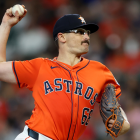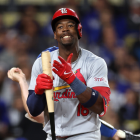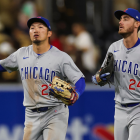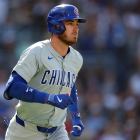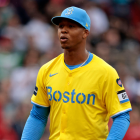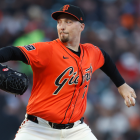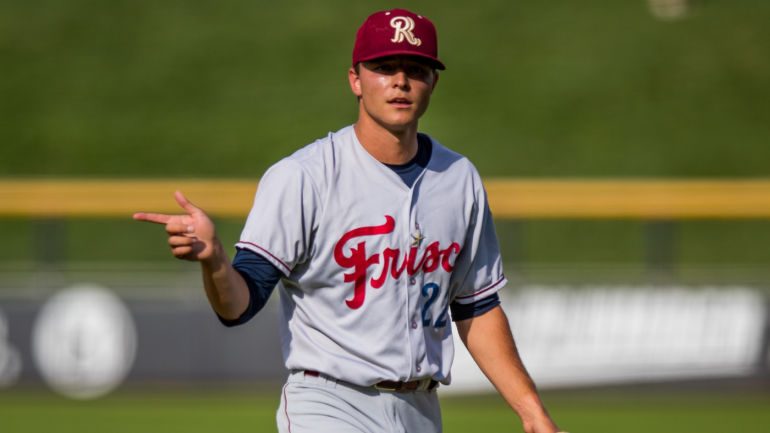
The Baltimore Orioles will kick off this year's Major League Baseball draft on Sunday, July 17 (or, in two weeks' time) by making the first overall selection for the third time in franchise history. In the interim, CBS Sports is in full preview mode: you can find our top-30 rankings and our latest mock draft by clicking the respective hyperlinks.
This week's Prospect Watch continues the trend, and is dedicated to highlighting five first-round picks from last summer's draft who have had notable performances -- good or bad -- in their first full professional seasons. (Do note that we've omitted No. 1 pick and Pittsburgh Pirates catching prospect Henry Davis after covering him last week, and that the five players below are listed in the order they were selected.)
Jack Leiter, RHP, Texas Rangers (No. 2 pick)
Leiter was the first pitcher off the board last July on the strength of his top-notch fastball and budding secondaries, as well as his bloodlines and makeup. It may come as a surprise, then, that he's posted a 5.36 ERA and a 2.14 strikeout-to-walk ratio in 48 innings. To be charitable, he's spent the season in Double-A, where he's nearly three years younger than his average rival; to be less charitable, the strike zone is the oldest and most formidable opponent any pitcher will ever face, and lately he's been losing the battle by recording 13 walks (vs. 16 strikeouts) over the course of 14 June innings. The Rangers have been conservative with Leiter's workload, limiting his pitch count and even giving him a one-inning start to allow for additional rest; he's also skipping his next turn in the rotation because of what the Rangers are describing as general arm fatigue. We're not going to sound any alarms yet -- he was always going to require some baking time until he fine-tuned his breaking ball command -- but we understand feeling as though his first season has been a (relative) letdown.
Some Highlights from Jack Leiter's Debut! 🔥 pic.twitter.com/b5mWjLhLca
— Rob Friedman (@PitchingNinja) April 10, 2022
Andrew Painter, RHP, Philadelphia Phillies (No. 13)
Here's a simple rule of thumb: you make this kind of piece if you're a 19-year-old averaging 16 strikeouts per nine innings after more than a couple of starts. Painter bullied his Florida State League competition, amassing a 1.40 ERA and a 4.31 strikeout-to-walk ratio (including a 46 percent K rate) in nine starts before the Phillies promoted him to the South Atlantic League (High-A) a few weeks ago. He made one start there and he's since been sidelined for load management purposes. There's always significant risk in selecting a prep righty early in the draft. Painter, complete with a large frame and a promising arsenal that includes a power fastball and advanced changeup, seems intent on validating the Phillies' decision to gamble.
🔥🦀🔥🦀 Andrew Painter's first BlueClaws inning: K looking / K swinging / K swinging. @PhilsPlayerDev pic.twitter.com/B9wRQVmSYd
— Jersey Shore BlueClaws (@BlueClaws) June 12, 2022
Matt McLain, SS, Cincinnati Reds (No. 17)
McLain, the first collegiate infielder selected last summer, went a few picks later than expected in part because of his below-average power projection. Naturally, he's launched 12 home runs -- or, four fewer than he had in his whole UCLA career -- in his first 59 games at Double-A. His secret, so far as we can tell, is a newfound obsession with lifting and pulling the ball: roughly half his batted balls have been yanked to the left side of the field, and more than 60 percent overall have caught air, according to FanGraphs. An unfortunate byproduct of that philosophy has left McLain prone to strikeouts (over 30 percent) and pop-ups (nearly 20 percent of his flyballs), resulting in a .237/.352/.470 slash line that bears little resemblance to expectations. McLain is currently out with an unspecified injury, but it'll be interesting to monitor how his new outlook fares against Triple-A pitching once he returns and is promoted.
Third-ranked @Reds prospect Matt McLain launched his first homer since May 22 on this drive to left for the @ChattLookouts. pic.twitter.com/ehcRx4rA74
— MLB Pipeline (@MLBPipeline) June 19, 2022
Trey Sweeney, SS, New York Yankees (No. 20)
Sweeney was the second collegiate infielder taken in 2021. His pro career hasn't started the way we expected it would, either, as he's already struck out more times in 52 games at High-A than he did in nearly 120 games at Eastern Illinois. We're giving him a pass for the time being because he's made adjustments to his swing to alleviate his barrel wrap, a tic that scouts expressed concern about heading into the draft. Sweeney has performed better as of late, too, hitting .270/.363/.472 in 23 June games.
Tyler Black, UTL, Milwaukee Brewers (No. 33)
We'll conclude with yet another collegiate infielder. Black has hit .291/.406/.455 with 19 extra-base hits, 11 steals, and nearly as many walks as strikeouts in 52 games at High-A -- marks that suggest he's not long for the level. What's more interesting to us about his season to date is how the Brewers have deployed him defensively.
.@tylerblack_6 hustles into 2nd for a Double and scores Ashton McGee giving the Rattlers a 4-2 lead in the 4th! pic.twitter.com/emfW7cdjYn
— Wisconsin Timber Rattlers (@TimberRattlers) June 22, 2022
Scouts considered him to be a pure second baseman heading into the draft, putting the onus on him to hit if he wanted to retain value. The Brewers have treated him as a second baseman primarily, however, they've also tested the waters elsewhere by having him start a combined 15 games in center field and at third base. Any extra defensive value Black can provide would go a long way in securing him a big-league future.















